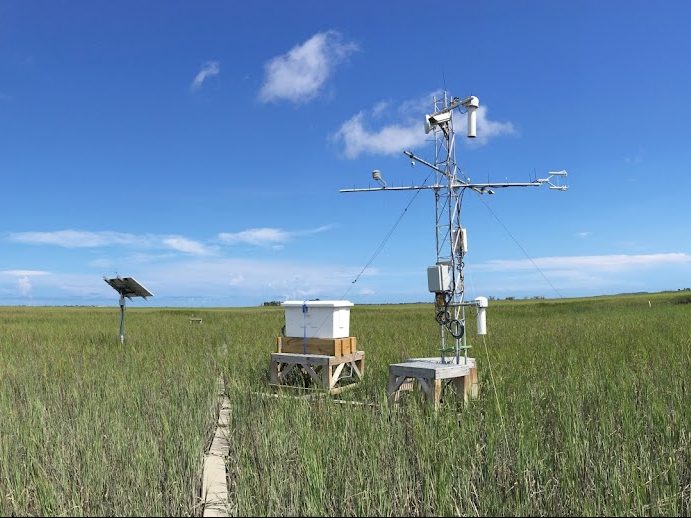
CH4 and CO2 flux measurements carried out at the NGEE-Arctic/AmeriFlux US-NGC Council, Alaska site, which is a lichen-rich subarctic tussock tundra on underlying continuous permafrost. Photo cr. Sigrid Dengel.
On behalf of co-authors Sara Knox, Rob Jackson, and Ben Poulter
Inviting the entire flux community to participate! Take the survey.
As part of a recent Global Carbon Project methane budget activity funded by the Moore Foundation, we are organizing the collection and aggregation of global CH4 data from the flux tower community in coordination with the regional networks (including AmeriFlux) and FLUXNET. We aim to use this database for a global synthesis of CH4 flux tower data. By analyzing continuous, ecosystem-scale flux measurements, our synthesis should provide novel insights into the controls and timing of wetland CH4 emissions.
We also plan to apply machine learning algorithms to upscale site-level fluxes to develop a new globally gridded methane product, analogous to what has been done previously for CO2. This gridded product will provide an entirely independent estimate of global CH4 emissions to compare with process-based models and atmospheric inversions.
We have been working with a subset of sites measuring CH4 to assess the feasibility of this project. Last May we hosted a workshop in Washington DC with site PIs and representatives from AmeriFlux, EuroFlux and FLUXNET to:
- Address issues of data limitations, consistency, and standardization & long-term steps needed to integrate methane in future FLUXNET releases.
- Determine the best statistical approaches for developing gridded methane products.
- Identify knowledge gaps, key research questions, and opportunities for new synthesis activities and collaborations.
Now we want to invite the entire flux community to participate in this multiyear synthesis activity. Before we start, we ask you to fill out a short survey of three brief questions (see questions below). Results will facilitate inclusion of CH4 fluxes in FLUXNET and build consensus regarding authorship and data policies
Indicate that you are interested in contributing data to this activity, so we can contact you directly with instructions for data submission.
We look forward to your responses. Let us know if you have any comments, questions or concerns.
Sara Knox, Rob Jackson, and Ben Poulter

Methane and CO2 analyzer installed in the California San Francisco Bay Delta—US-Myb on Mayberry Island. Photo Cr. Sara Knox.
Survey questions
If you are unable to access the link to the survey, we have included the questions below, so you can provide your answers directly to us via email.
- If you have or are making eddy covariance measurements of methane, is your site currently registered in a regional flux network?
- If Yes, please provide the Site ID(s)
- If No, please provide the following information: Site PI and contact information, Site name, Latitude, Longitude, Site description, Vegetation type, Measurements start and end dates.
- Are you interested in contributing data to this synthesis activity?
- What data use policy would you prefer? Please classify the options below as a) preferred, b) acceptable, c) not acceptable.
- Option 1: share openly, everybody can access the data and will cite paper or DOI related to the dataset. Users are invited to contact the data owner for collaboration but it is not mandatory (basically Tier 1 in FLUXNET).
- Option 2: share openly but it will be mandatory to offer collaboration to the data owner and if additional intellectual input is provided to add him/her to the publications. Reference and DOI are also mandatory.
- Option 3: share data openly but for the first three synthesis papers it will be mandatory to include as coauthor one person per site (two if dataset longer than 3 years). After these three synthesis papers the data will be shared according to Option 2 for 2 years and then Option 1.
- Option 4: data are shared only internally in the group of data contributors for 2 years, where in all the papers initiated will be mandatory to include as coauthor one person per site (two if dataset longer than 3 years). After these two years embargo the data will be shared according to Option 1.




No Comments
Be the first to start a conversation